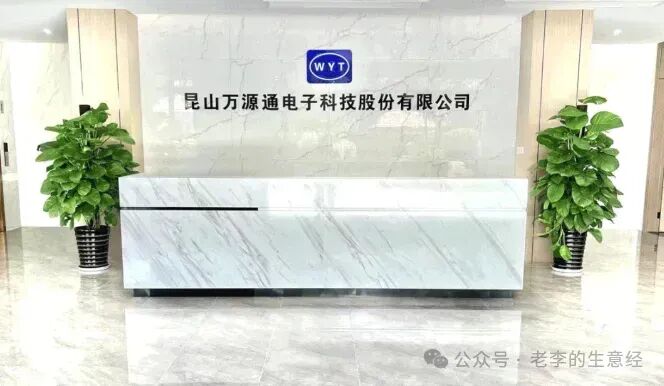1. Introduction to Wanyuantong: From Consumer Electronics to AI Computing Power “PCB Expert”
I am Lao Li, having navigated the stock market for many years, I have seen too many companies rise and fall. Recently, I have focused on a PCB company called Wanyuantong, not for any other reason, but because it has accurately positioned itself in both the AI server and new energy vehicle sectors. PCB might be unfamiliar to outsiders, but it is the “skeleton” of electronic products, connecting electronic components in everything from servers and cars to mobile phones and home appliances.
Wanyuantong’s main business is printed circuit boards (PCBs), with products ranging from single-sided boards to multi-layer boards, and its major clients include industry giants like Delta, LG, and Luxshare Precision. However, what truly impressed me was its layout in the AI server and optical module fields. At the end of last year, the company began supplying PCBs for uninterruptible power supplies (UPS) for AI servers, which are critical components that ensure servers can continue to operate during power outages. Even more impressive, they are developing PCBs for 600G optical modules, which can significantly increase data transmission speeds in data centers; there are only a handful of companies globally capable of producing these.
2. Financial Health Check: A “Cash Cow” with Concerns
Looking at Wanyuantong’s financial report, the revenue for 2024 is projected at 1.043 billion, with a net profit of 123 million, which seems stable. However, upon closer inspection, the revenue growth rate has dropped from 39.71% in 2022 to 5.97% in 2024, and the net profit growth rate has plummeted from 124.75% to 4.45%. This reminds me of an old saying: a “slow bull” can turn into a “snail,” so caution is warranted.
On the other hand, the company’s gross margin has remained stable at around 22%, and cash flow is also good, with an operating cash flow of 0.72 yuan per share in 2024. This indicates that it is still a “cash cow,” but growth has encountered bottlenecks. Additionally, looking at R&D investment, which exceeds 40 million each year, the company holds 87 patents, 11 of which are invention patents. These technological accumulations may one day become new growth points. 
3. Industry Trends: The “Dual Drive” of AI Computing Power and New Energy Vehicles
The PCB industry is like a “treasure chest,” with significant differences in demand across various application scenarios. Wanyuantong’s intelligence lies in its simultaneous capture of two major trends:
-
Explosion of AI Computing Power: The global AI server market is expected to grow from 19.4 billion in 2023 to 28.7 billion by 2029. Wanyuantong’s high-end PCBs can meet the demands of AI servers for high reliability and high-frequency, high-speed transmission. Particularly, the 600G optical module PCBs, if successfully developed, could become the next profit growth point.
-
Intelligentization of New Energy Vehicles: The demand for automotive electronic PCBs is increasing every year, especially for battery management systems (BMS) and autonomous driving modules. Wanyuantong has already supplied to car manufacturers like Tesla, NIO, and Xpeng, with revenue from the new energy vehicle sector increasing from 24% in 2021 to 41% in 2024.
These two trends combined act like a “dual engine” for Wanyuantong. However, there are also significant risks, such as fluctuations in raw material prices (copper-clad laminates and copper foil account for over 40% of costs) and high customer concentration (the top five customers account for 60% of revenue).
4. Competitive Advantages: The “Moat” of Technical Barriers and Customer Loyalty
Wanyuantong’s survival in the red ocean of the PCB market relies on two key strengths:
-
Technical Barriers: The company has mastered core technologies such as high-precision drilling and metal-based circuit board processing, with multi-layer board yields exceeding the industry average by 5 percentage points. Particularly in the high-frequency, high-speed board sector, it is one of the few domestic companies capable of producing PCBs for 5G base stations.
-
Customer Loyalty: Clients like Delta and LG have been partners for over five years, and Luxshare Precision has even designated it as a “strategic supplier.” Such long-term partnerships are not built overnight; they require solid quality and rapid response capabilities.
However, competitors should not be underestimated. Leading companies like Pegatron and Shenzhen South China Circuit are increasing their investments in AI and automotive electronics, and Wanyuantong’s market share could be squeezed at any time.
5. Risk Warnings: Unavoidable “Reefs”
Investing in Wanyuantong requires special caution regarding these three “landmines”:
-
Customer Dependence: The top five customers account for 60% of revenue, with Luxshare Precision alone accounting for 25%. If orders from major clients decrease, performance will be immediately affected.
-
Expansion Risks: The company is raising 256 million to build a new energy vehicle PCB project, expected to be operational by 2026. However, overcapacity in the PCB industry is an old problem, and whether the new capacity can be absorbed remains uncertain.
-
Raw Material Price Increases: The price of copper-clad laminates increased by 15% in 2024, directly eating into 3 percentage points of gross margin. Although the company has alleviated some pressure through price-lock contracts, cost pressures still exist in the long term.
6. Valuation and Outlook: Cheap or Expensive?
Huayuan Securities has given Wanyuantong a valuation of 34.7 times PE for 2025, which is not cheap compared to industry peers Pegatron (25 times) and Shenzhen South China Circuit (30 times). However, considering its high growth potential in AI and automotive electronics, this valuation is also reasonable.
In the next three years, if the AI server and optical module businesses can scale successfully, net profit is expected to grow from 123 million to 171 million. However, this is contingent on the company maintaining its lead in technology R&D and customer expansion while avoiding the impacts of industry cyclical fluctuations.

Disclaimer: This article is a personal diary and does not constitute investment advice. All opinions expressed in this article are solely my own and do not have any guiding significance.